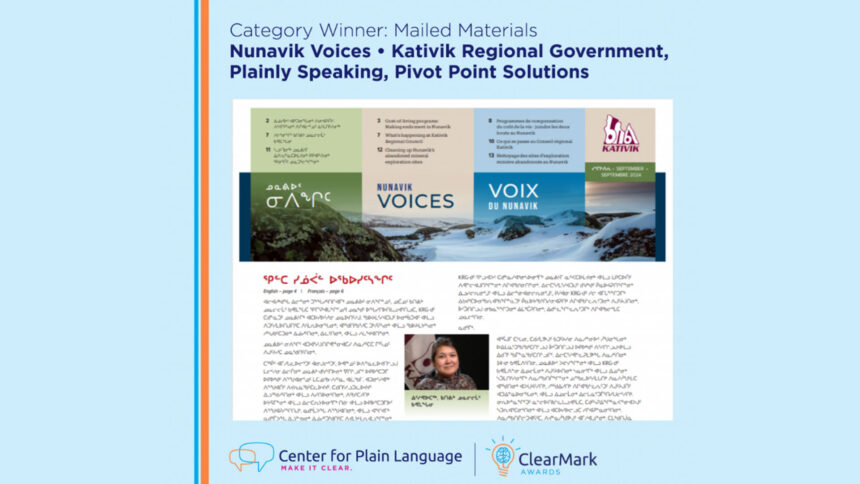A magazine from Nunavik has won an award for its clear communication style from a language centre based in the United States. The trilingual Nunavik Voices has won the ClearMark Award from the U.S. based Center for Plain Language for its success in delivering information at a level nearly all readers could understand. “It effectively addresses users in three languages in one publication,” the Center for Plain Language’s judges noted. “This not only allows all community members (within and across households) to read it. It also signals that the community is united and that each language is important and valued, highlighting the Inuktitut language given its cultural significance.” Denis Abbott, is the Kuujjuaq-based director of communications for Kativik Regional Government (KRG) who led the development of the publication. “It’s the start of something,” he tells APTN News, “and it all comes from a good place with a lot of very, very good people and a lot of great support and guidance.” When the Kativik Regional Government set out to create a new way of communicating with its citizens, it aimed to offer a single source of information to residents of Nunavik’s 14 geographically isolated communities. They decided they would make a quarterly printed magazine, called Nunavik Voices. Less than a year after the first issue was released in fall 2024, the publication has already won an international award. “Plain-language writing” is a style that many people have encountered, but few have noticed. It refers to writing in a clear manner that isn’t complicated by large or unfamiliar terms, long sentences, or confusing style choices. The idea for plain-language writing is texts that nearly anybody can read and understand, regardless of their reading level or their mother tongue. For that reason, plain language writing is essential for Indigenous communities, particularly those where residents speak their ancestral tongue first but get communications in English. Nunavik Voices aims to do all that—but it also goes well beyond English. Because Nunavik is located in Quebec and most residents speak Inuktitut first followed by English and or French, the magazine was designed from the first to be trilingual. Abbott said the KRG wanted a magazine that everyone can read. “You’ve probably seen any number of trilingual publications based in the North,” he notes. “They usually present one language, then the second one, and then [the third], chop, chop, chop. It automatically suggests kind of an order of priority or precedence, which is not really what the Kativik Regional Government wanted. “It wanted all languages to be seen [as having] equal importance. And also to recognize the fact that many, many people in Nunavik are multilingual.” Abbott and his team organized discussions and attempted to get as much feedback as possible. They found most people they spoke to appreciated the way all three languages had equal status on the page. “[Readers] were interested in one story idea in a particular language, you could follow it in another, so they had no problem following,” he says. “Once they understood the logic, they could understand the navigation, and they loved it.” Abbott credits the company Plainly Speaking and its founder Nicole d’Entremont with critical assistance in the publication. Abbott and d’Entremont worked with KRG to figure out how plain language would work differently in the North. After all, Abbott says, what works as plain language for a Torontonian is liable to have a totally different meaning to an Inuk. “[Inuit] have a whole different understanding, and one of the things that I’ve learned and I’ve been counseled on a lot is the use of visual imagery, the telling of stories within narratives. In other words, if you’re a press release, you should be telling a story within this to help people relate.” Abbott is quick to stress the real foundation of the project came in the form of contributions from elders. Without Elders’ input, Nunavik Voices could never have applied the principles of plain-language writing to its Inuktitut sections. “What I’ll call our leaders, our Elders, [guided] us with words and images and storyline construction,” Abbott explains. “So we have our executive committee that review each edition, and they provide suggestions and advice on not only the spoken word, but the way that the stories are told. And they provide us guidance. “We get absolutely fantastic feedback in terms of how these stories are expressed, and also the local vernacular as well.” Abbott says Elders and other community members gave plenty of guidance about what subjects they wanted to hear about in Nunavik Voices. He says the team also worked with KRG’s regional council to make sure it was addressing issues important to all 14 Nunavik communities. As a result, the magazine covers subjects ranging from emergency management to local picnics and games, recycling programs, and discussions about how communities can organize themselves. “You can appreciate isolated communities: people rarely have the voice,” Abbott says. “They rarely receive the communication. It’s about lifting voices and lifting the capacity of the regional government to tell people what’s going on. [That allows] the residents themselves to feel as though they have someone, there is a voice that they can go to, someone has their back if there’s an emergency.” The next issue of Nunavik Voices will be on newsstands during the first week of August, but even now it’s still changing. What began as a printed magazine will soon have an interactive digital edition with options for added information, and Abbott is excited about how this might open the magazine’s readership to a wider audience than ever. “Government should all be about service, service to individuals,” Abbott says. “Part of service means communication.” Continue Reading
Nunavik Voices wins international plain-language writing award

Leave a Comment









